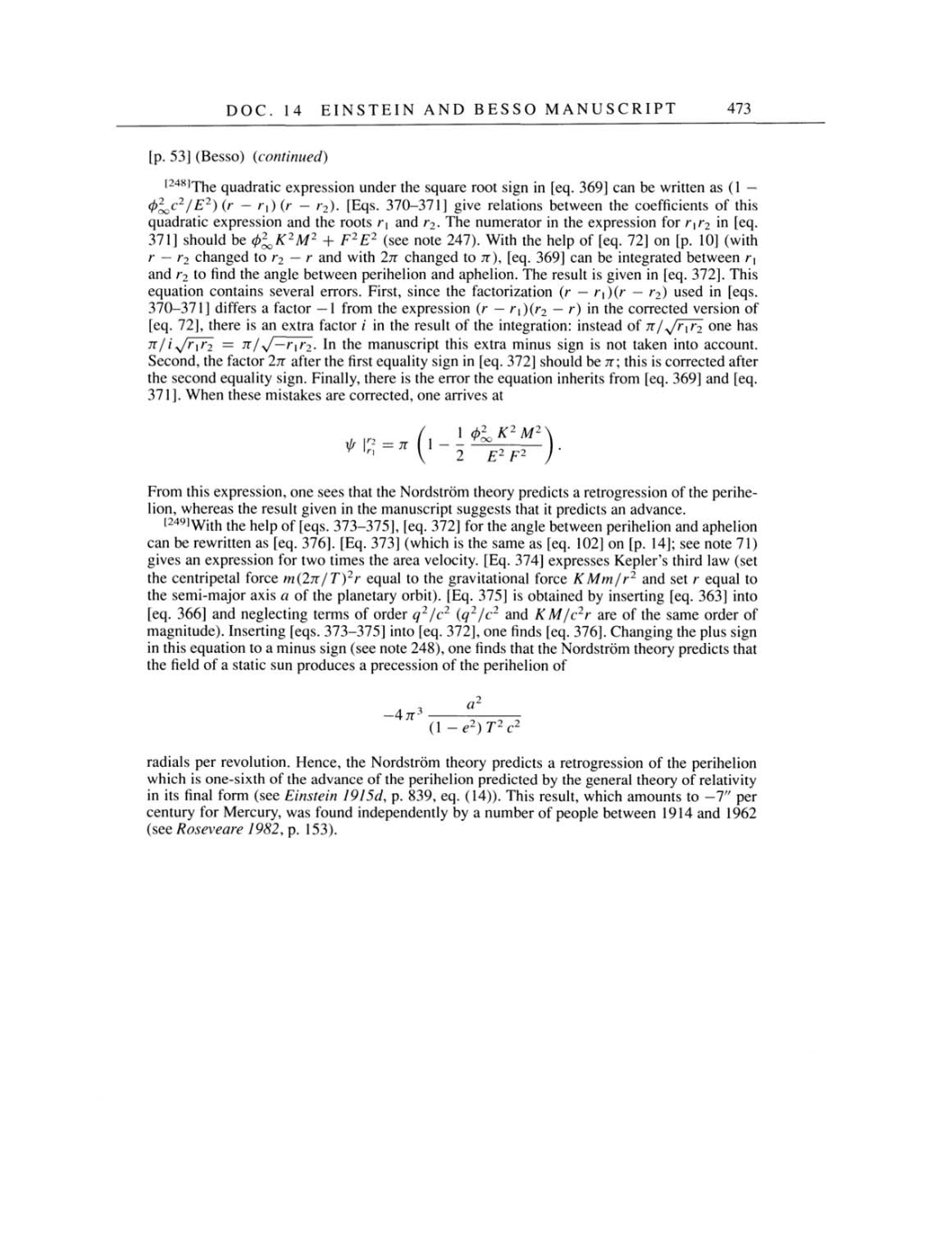DOC. 14
EINSTEIN
AND
BESSO MANUSCRIPT
473
[p. 53]
(Besso) (continued)
[248]The quadratic expression
under
the
square root
sign
in
[eq. 369]
can
be
written
as (1
—
p)2ooC2/E2)
(r
—
r1)(r
—
r2).
[Eqs.
370-371]
give
relations between the coefficients of
this
quadratic expression
and
the
roots
r1
and
r2.
The
numerator
in the
expression
for
r1r2
in
[eq.
371]
should
be
(p2ooK2M2
+
F2E2
(see
note
247).
With
the
help
of
[eq.
72]
on [p. 10]
(with
r
—
r2
changed to
r2
—
r
and with
2tt
changed
to
jz),
[eq.
369] can
be integrated
between
r1
and
r2
to find
the
angle
between
perihelion
and
aphelion.
The result
is given
in
[eq. 372].
This
equation
contains
several
errors. First,
since
the factorization
(r
—
r1){r
—
r2)
used
in
[eqs.
370-371]
differs
a
factor
—1
from the
expression (r
—
r1)(r2
—
r) in the corrected version
of
[eq.
72],
there
is
an
extra
factor
i
in the
result of the
integration:
instead
of
n/r1r2
one
has
7r/iy/r1r2
—
nI\/—r1r2. In the
manuscript
this
extra
minus
sign
is not
taken
into
account.
Second,
the factor
2tc
after the
first
equality
sign
in
[eq. 372]
should
be
7r;
this
is
corrected after
the
second
equality
sign.
Finally,
there
is
the
error
the
equation
inherits
from
[eq. 369]
and
[eq.
371].
When these mistakes
are
corrected,
one
arrives
at
w
|r2r2
= n
(1
-
1/2
p2ooK2M2/E2F2)
.
From
this
expression,
one sees
that the
Nordström
theory predicts
a
retrogression
of
the
perihe-
lion,
whereas the result
given
in the
manuscript suggests
that
it predicts
an
advance.
[249]
With
the
help
of
[eqs.
373-375],
[eq.
372]
for the
angle
between
perihelion
and
aphelion
can
be
rewritten
as [eq.
376].
[Eq.
373]
(which
is
the
same as [eq. 102] on
[p.
14]; see
note
71)
gives an
expression
for
two
times
the
area velocity. [Eq. 374]
expresses Kepler's
third
law
(set
the
centripetal
force
m(2n/T)2r
equal
to
the
gravitational
force
KMm/r2 and
set
r
equal to
the
semi-major
axis
a
of the
planetary
orbit).
[Eq.
375] is
obtained
by
inserting
[eq.
363]
into
[eq. 366]
and
neglecting terms
of order
q2/c2 (q2/c2 and
KM/c2r
are
of the
same
order of
magnitude). Inserting
[eqs.
373-375]
into
[eq.
372],
one
finds
[eq. 376]. Changing
the
plus
sign
in this
equation to
a
minus
sign
(see note 248),
one
finds that
the
Nordström
theory predicts
that
the field
of
a
static
sun
produces
a
precession
of
the
perihelion
of
-4n3
/(1
-
e2)
T2c2
radials
per
revolution.
Hence,
the Nordström
theory predicts
a
retrogression
of
the
perihelion
which
is
one-sixth of
the
advance of
the
perihelion predicted
by
the
general theory
of
relativity
in its final form
(see
Einstein
1915d,
p.
839,
eq.
(14)).
This
result, which
amounts to —7" per
century
for
Mercury,
was
found
independently
by a
number of
people
between
1914 and 1962
(see
Roseveare
1982,
p. 153).
